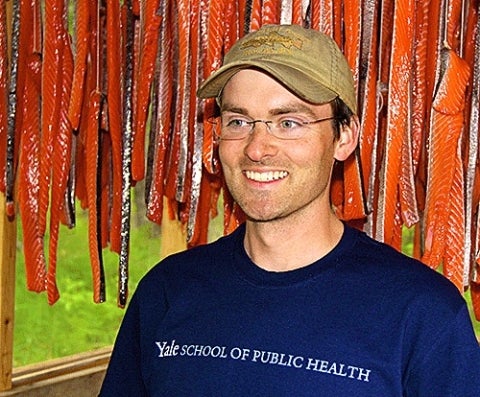Note: Yale School of the Environment (YSE) was formerly known as the Yale School of Forestry & Environmental Studies (F&ES). News articles and events posted prior to July 1, 2020 refer to the School's name at that time.
 David Krause
David Krause
Q: What are some of the connections between salmon and public health that you’re exploring in Bristol Bay?
David Krause: Food, and food security, is one connection between wild salmon ecosystems and human health that I’m looking at. Salmon is a critical food source for people in Alaska, and it has been for thousands of years. But I’m also researching how the cultural values and social networks that surround salmon, and the preparation of salmon for food, contribute to community health in these remote places. Finally, I’m exploring how the physical activity of subsistence practices and the spiritual importance of wild salmon are related to peoples’ health. Salmon contribute to health in a truly holistic way.
Q: How might salmon help create social networks, and how is that useful for public health?
Krause: An example might be if younger people visit their elders to share fish, and in the process also help chop firewood for the winter or simply hang out for a good conversation. Fish are a vehicle that brings people together, and this helps facilitate relationships that contribute to overall wellness. It could equally be said that if you take care of public health in these communities, you’re also working to protect these fisheries, because you’re helping the people who are the stewards of the last great wild salmon ecosystems.
Q: I’d imagine that remote communities in Bristol Bay face public health challenges that towns in the lower 48 might not experience.
Krause: Suicide, mental health problems, substance abuse, accidental death, and violence are all huge concerns out here, and social networks help mitigate these issues. There’s also an increased trend in chronic diseases like diabetes and obesity, which may be due to a divergence away from traditional, wild foods and toward processed food. Think less salmon, more Fritos.
Related Story
 <h4> <a href="/news/article/rahr-new-defense-for-wild-salmon-populations">A New Line of Defense<br /> For Wild Salmon Populations</a></h4>Since the late-1990s, <strong>Guido Rahr</strong>, M.E.S. '94, head of the Wild Salmon Center, has helped craft new strategies to restore populations of the Pacific salmon, a species whose numbers plummeted during the 20th century.
<h4> <a href="/news/article/rahr-new-defense-for-wild-salmon-populations">A New Line of Defense<br /> For Wild Salmon Populations</a></h4>Since the late-1990s, <strong>Guido Rahr</strong>, M.E.S. '94, head of the Wild Salmon Center, has helped craft new strategies to restore populations of the Pacific salmon, a species whose numbers plummeted during the 20th century.
Q: So is salmon still important as a subsistence food source?
Krause: Salmon is absolutely a huge source of protein for remote communities. I think something like 50 percent of traditional food energy comes from fish. And with salmon, of course, there are nutrients and omega-3 fatty acids that make it more beneficial than eating the expensive, poor-quality beef and chicken that you find in many village stores.
Q: I know you’ve worked in Alaska in the past. How did your previous work with salmon inform your current research?
Krause: About ten hours after I graduated college, I left for Alaska to work for the subsistence branch of the Fish and Wildlife Service on Yukon River tributaries. And immediately I saw how powerful these fish are in the communities they swim through.
I worked close to the mouth, mid-river, and way upstream above the Arctic Circle. People at the mouth of the river are usually able to meet their subsistence needs. In the upper sections of the river, however, there are far fewer fish, both because many fish diverge off the main steam of the Yukon into tributaries, and because of recent steep declines in the king salmon run. The anxiety and stress from these low numbers of fish was certainly visible, and you could see a whole host of related public health issues, like substance abuse, emerging from reduced subsistence and commercial fishing opportunities.
Q: Since you’ve been in Dillingham, have you had the chance to take part yourself in any of these traditional salmon activities?
Krause: We’ve been fortunate enough to spend a lot of time with a lifelong Dillingham resident, helping her process and hang up strips of king salmon on the drying rack in her smokehouse. You can read about these practices in books and journal articles, but actually participating has contributed so much to my understanding of the connections between the community and the resource, and just how much people value these fish.
About the Author
Ben Goldfarb is a 2013 graduate of the Yale School of Forestry & Environmental Studies, where he served as editor of Sage Magazine. He is a Seattle-based correspondent for High Country News, a magazine that covers environmental issues throughout the American West.